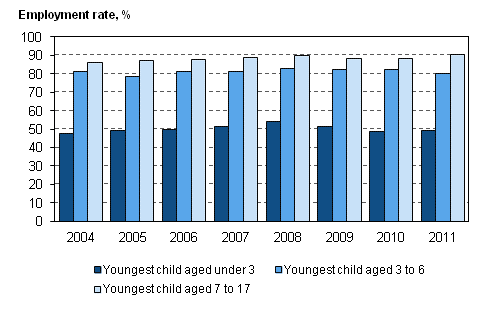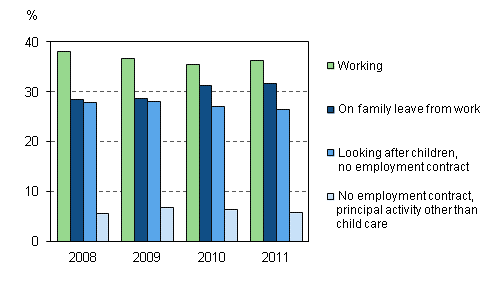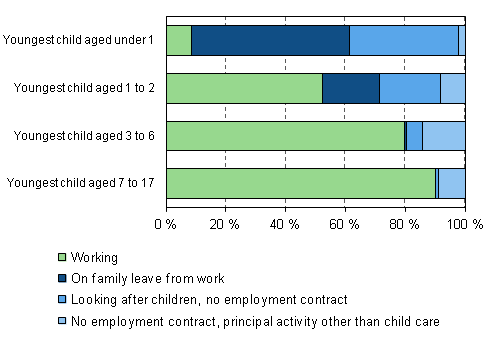3. Mothers’ use of family leaves has become slightly more widespread
The age of the youngest child in the family has a distinct effect on the employment of mothers aged 20 to 59 (Figure 5). Only about one-half of mothers are employed if their youngest child is aged under three. Mothers’ employment rate rises to 90 per cent or so, i.e. to the same level as fathers’, only once the youngest child has reached school age. Fathers’ employment rate, in turn, remains equally high irrespective of the age of their children. This means that mothers still continue to take most of the long family leaves.
Figure 5. Employment rates for 20 to 59-year-old mothers by age of their youngest child in 2004-2011

However, the employment rate alone does not describe the proportion of the parents of young children who actually work. Persons on maternity or paternity leave from work as well as persons whose absence from work has lasted under three months are classified as employed in the Labour Force Survey. Thus, especially in the case of mothers of very small children the employed contain many mothers who are actually at home looking after a child. Respectively, mothers on child care leave are mostly classified as inactive population (persons outside the labour force) because the care leave is often taken after the maternity leave and parental leave, which lengthens the total duration of the leave.
Figure 6 shows as a separate group those mothers of under three-year-old children who actually go to work. It also describes separately the mothers on family leave (maternity, parental or child care leave) from an employment relationship and the mothers without a valid employment contract who are looking after their children at home. The fourth group consists of those who have said their principal activity is something else than child care. This group includes such as students and unemployed persons.Figure 6. Working and family leaves of 20 to 59-year-old mothers with children aged under three in 2008-2011

The economic downturn that started at the turn of 2008 and 2009 was reflected in the working of mothers of small children in that the share of those on family leaves grew slightly and correspondingly, that of those working fell to some extent. The situation in 2011 has remained more or less the same as in 2010. (Figure 6.)
When the mothers on family leaves are separated from those working, it can be seen that in reality only about one-third of the mothers of under three-year-olds were working in 2011. However, the groups of mothers of under one-year-olds and mothers of one to two-year-olds are very different (Figure 7). Of the mothers whose youngest child was aged under one, good eight per cent were working, over one-half were on family leave and good one-third were at home caring for the child and did not have a valid employment contract. When the youngest child was aged between one and two, as many as over one-half of the mothers were working. Thus, the share of mothers who work rises fast as the youngest child grows older when the mothers either return from family leave or find employment.
Figure 7. Working and family leaves among 20 to 59-year-old mothers by age of their youngest child in 2011

Fathers usually take shorter family leaves than mothers do. During the paternity leave, the “daddy” month or the care leave of under three months, fathers are classified as employed so family leaves have little impact on the employment rate of fathers. The picture of the employment of fathers hardly changes when the fathers on family leave are separated from the fathers who are working, because only two per cent of the fathers of under three-year-olds were on a family leave during the survey week in 2011.
Source: Labour Force Survey 2011. Statistics Finland
Inquiries: Heidi Melasniemi-Uutela 09 1734 2523, Tarja Nieminen 09 1734 3561, tyovoimatutkimus@stat.fi
Director in charge: Riitta Harala
Updated 11.9.2012
Official Statistics of Finland (OSF):
Labour force survey [e-publication].
ISSN=1798-7857. Families and work in 2011 2011,
3. Mothers’ use of family leaves has become slightly more widespread
. Helsinki: Statistics Finland [referred: 14.12.2025].
Access method: http://stat.fi/til/tyti/2011/14/tyti_2011_14_2012-09-11_kat_003_en.html

